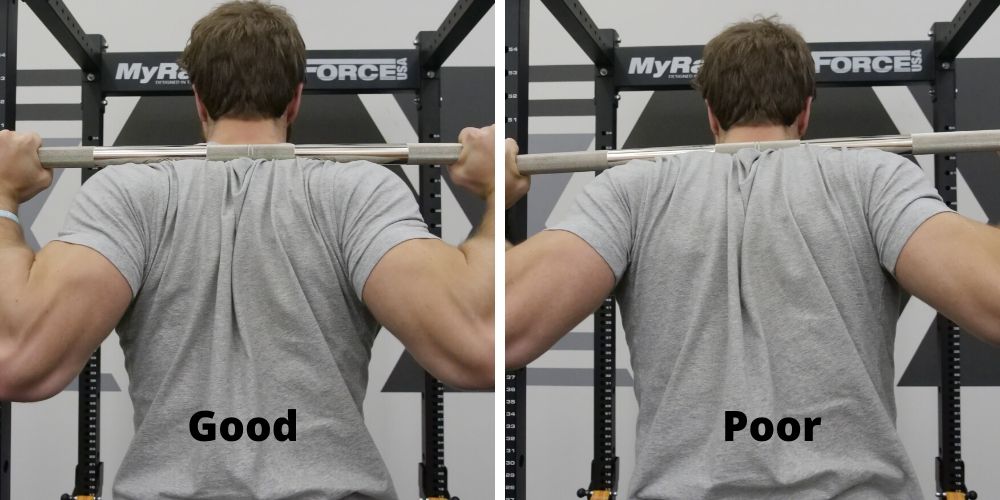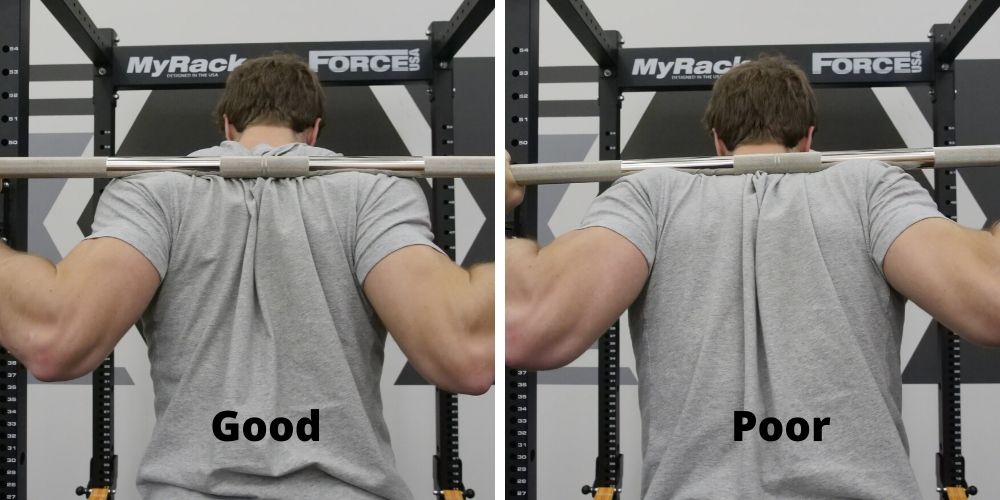There are a ton of useful cues to help promote strong squat mechanics. From the feet to head position, every lifter and coach has their own way of conveying what is mechanically appropriate throughout the squat for various athletes and lifters to understand.
Cues are fantastic because they’re a means to help lifters conceptualize what is needed to perform and execute a task. However, without a coach physically present to demonstrate something, it can be tough at times to understand certain cues — especially when first starting out.
In this article, we’re going to discuss what it means when lifters and coaches say, “create a shelf” with the upper back during the squat. Whether you primarily squat low-bar or high-bar, the act of creating a shelf or packed upper back position is essential for strong squats.
What Does It Mean to Create a Shelf When Squatting?
The squat cue “create a shelf” entails how we position the upper back to hold a barbell in a fixed position. It’s similar to how an actual shelf holds things on a wall, as the upper back serves as a physical shelf for the barbell to sit upon. By creating this shelf, the barbell then sits tighter on the body and doesn’t feel like it’s pressing into the bone — which is a common complaint from beginners.
To create a shelf, there are a couple things an athlete needs to keep in mind. For example, it’s not enough to simply pull the traps/scaps together to create a shelf, grip and elbow position also play a role in the equation. Below are a couple guidelines to keep in mind.
Author’s Note: Before reading further into the cues and examples, it’s important to recognize that everyone’s position will be slightly different and the below is intended to help you find what’s best for you, but not serve as the perfect form for everyone.
For High-Bar Squats
High-Bar Typical Bar Position: On top of the traps.

- Step 1: Pull the traps and scaps together, so the barbell sits on top of the traps. Ideally, there should be limited to no downward depression with the barbell when unracking. For example, if the barbell presses straight into the bone on the spine when un-racking, then you need to reposition.
- Step 2: Pull the elbows back, then down and ensure the torso is stacked and the chest is not flared upward. I like to think as if there’s a string pulling the elbows together, then that string is getting pulled downwards, so the elbow angle is somewhat similar to the torso angle. Avoid having the elbows and chest flare up excessively when doing this, as this can push the bar forward and cause the torso to collapse.
- Step 3: Think about actively pulling the bar into the traps.
- Step 4: Establish a grip width that allows you to perform the above two points without pain, or need to readjust mid-set. Upper body mobility and anthropometrics will play a role in what’s best for you, so use the above cues to help guide you.
For Low-Bar Squats
Low-Bar Typical Bar Position: Across the rear delts, exact position will vary from athlete-to-athlete.

- Step 1: Pull the scaps together and slightly depress them, then position the barbell across the rear delts, which should also be contracted due to the scap retraction. The barbell should feel stable. If the upper body/chest instantly collapses when un-racking, then reset.
- Step 2: Pull the elbows together, then slightly down so they’re somewhat aligned with the torso. Avoid positioning the barbell on top of the rear delts (right image), as this can lead to the elbows flaring up in the concentric portion of the squat and a forward bar path. Think of the torso as a cylinder while maintaining your bar position.
- Step 3: Think about actively pulling the bar into the rear delts.
- Step 4: Establish a grip width that allows you to maintain this position. Note, with low-bar squat the wrists may feel a little pressure, so experiment with different grip widths and methods in doing so. At times, wrist wraps can help limit some of the pressure felt.
Wrapping Up
Like squat stance width, how you position the bar on the back will be individual, but there are a few performance pillars to keep in mind. Bar position should be dictated by what allows for optimal performance and limits the potential for technical breakdown such as the chest collapsing, or the bar moving mid-squat.
Bar Position FAQs
What does "create a shelf" mean when squatting?
The act of creating a shelf when squatting entails creating a tight upper back posture to position the barbell on that limits deviation or form breakdown when performing successful squats.
Where should the bar be when high-bar squatting?
Generally, the barbell will sit across the traps when performing high-bar squats. The bar should not be lying across the neck or directly pressing directly into the spinal bone.
Where should the bar be when doing low-bar squats?
For most powerlifters, the barbell will sit across the middle part of rear delts when performing low-bar squats. However, bar placement can vary slightly on the rear delts based on form, limb lengths, and mobility levels.